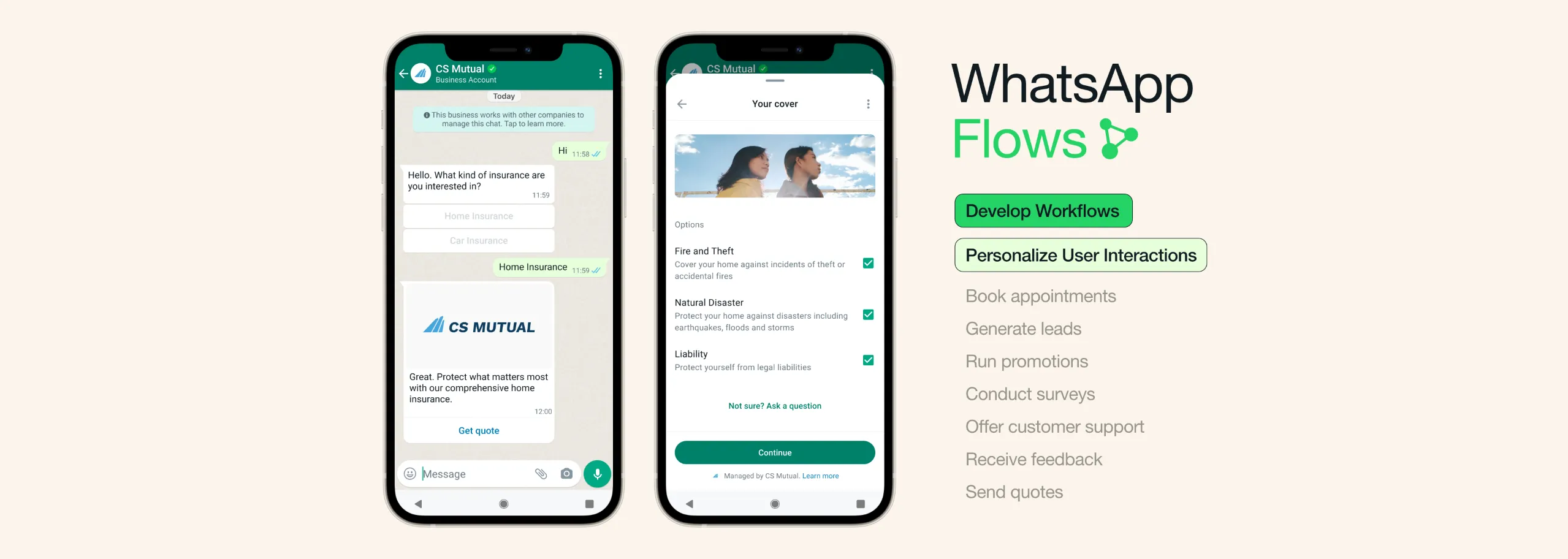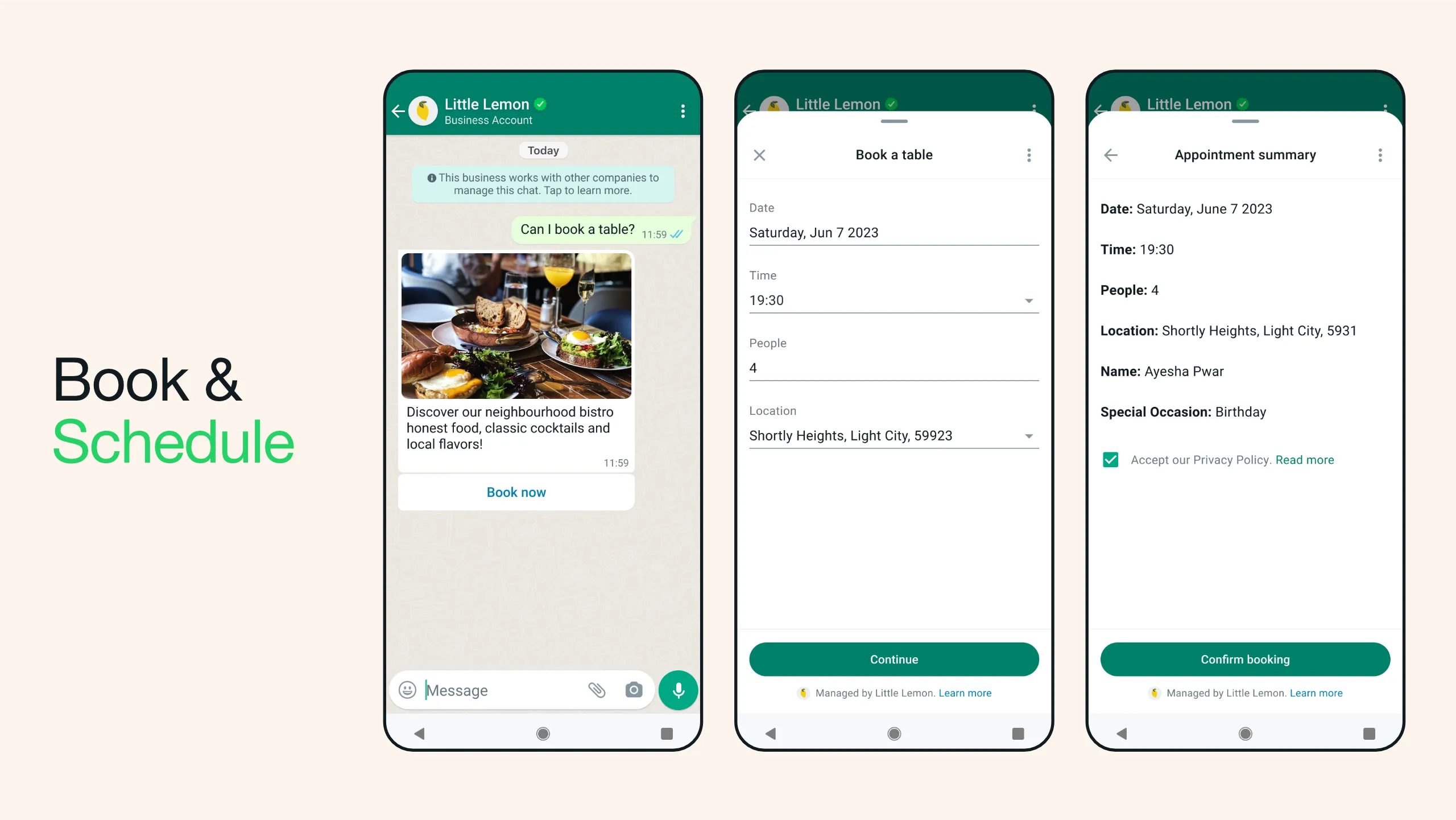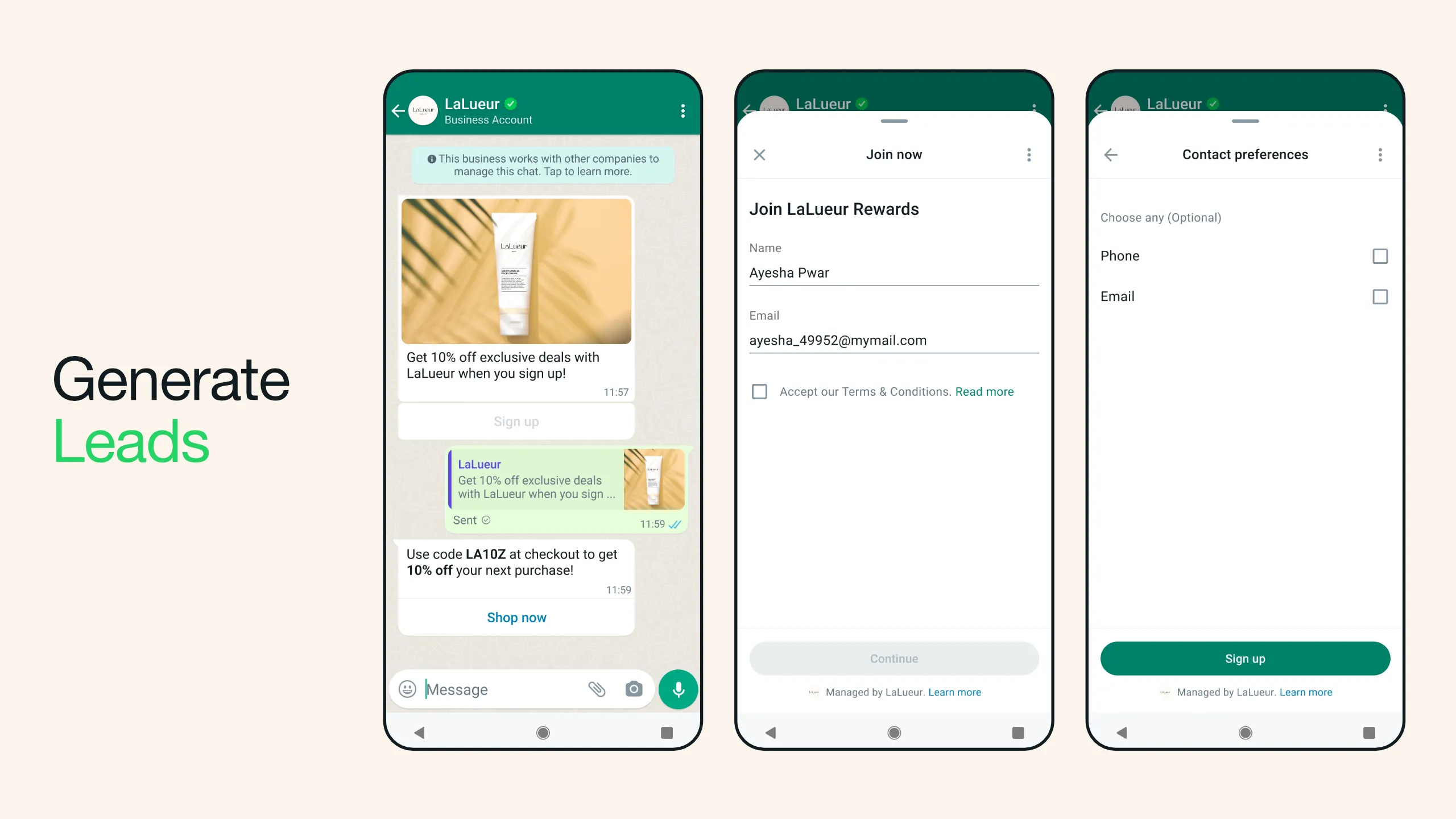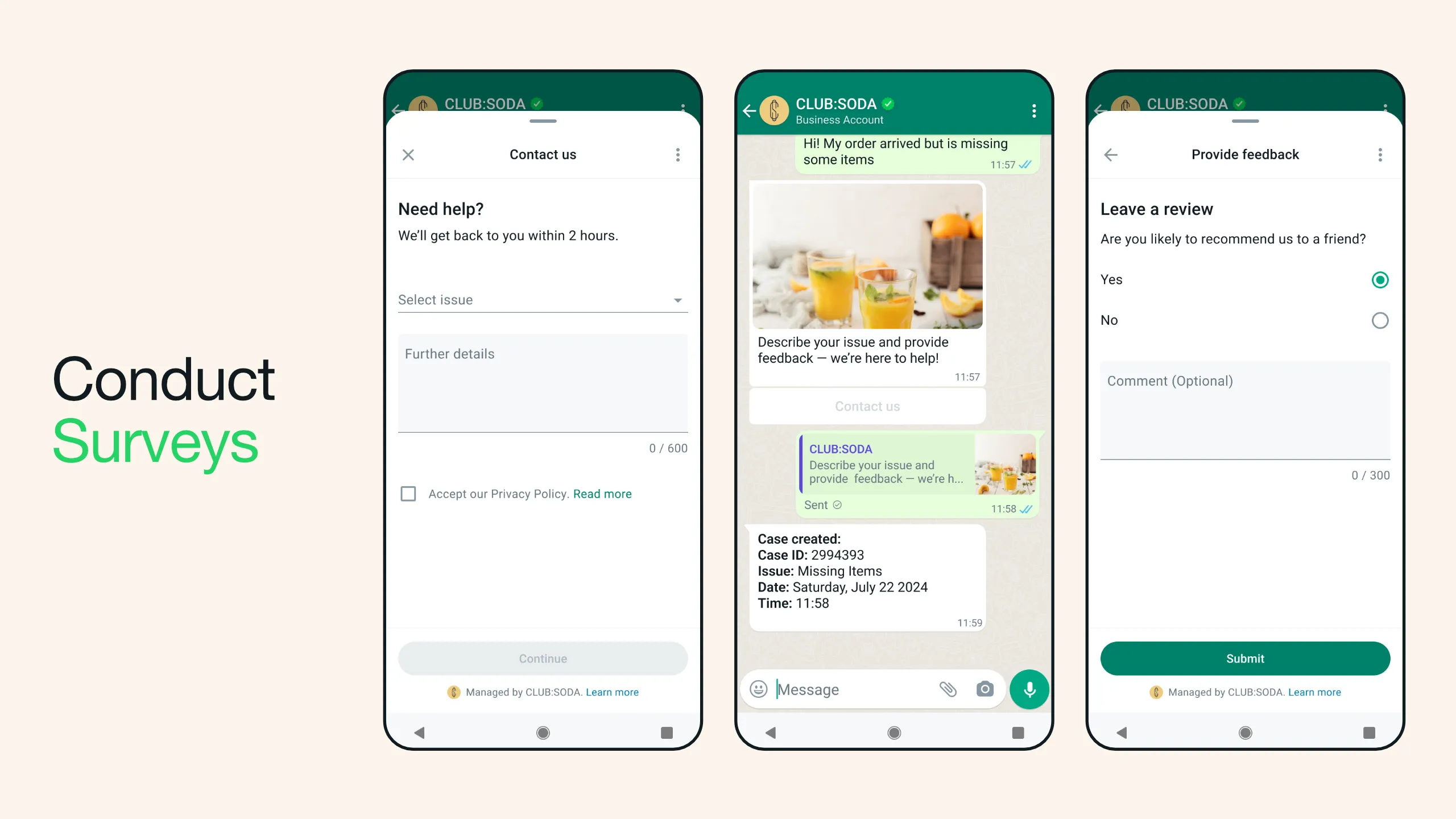
Desarrolladores
8 de noviembre de 2023
Aspectos básicos de WhatsApp Flows: introducción
WhatsApp Flows es una función de la Plataforma de WhatsApp Business que permite crear e implementar rápidamente flujos de trabajo nativos centrados en tareas en WhatsApp a fin de enriquecer las interacciones de los usuarios. Es un proceso que permite mejorar la finalización de las tareas, reducir el número de abandonos y lograr una mayor interacción de los usuarios.
Con WhatsApp Flows, una función de la Plataforma de WhatsApp Business diseñada para enriquecer las interacciones de los usuarios, las empresas pueden ofrecer experiencias interactivas dentro del chat y transformar conversaciones largas en interacciones rápidas y sencillas. Para mejorar la interacción entre las empresas y los usuarios, puedes crear formularios de entrada sencillos, diseñar flujos de trabajo con varias pantallas y establecer los extremos del intercambio de datos en el caso de interacciones más complejas.
En las próximas secciones, analizaremos en detalle los aspectos técnicos más importantes de WhatsApp Flows y exploraremos cómo te puede ayudar a crear experiencias de usuario interactivas.
Información básica sobre WhatsApp Flows
WhatsApp Flows es una puerta de acceso a experiencias de usuario interactivas dentro del ámbito familiar de la interfaz de chat de WhatsApp. Es un lienzo donde puedes crear, administrar y entregar flujos a medida, es decir, habilitas una vía de interacción con el usuario personalizada.
Tanto si tu objetivo es la simple recopilación de datos o una interacción compleja basada en la lógica condicional, WhatsApp Flows te ofrece herramientas versátiles que se adaptan a distintos niveles de complejidad y personalización.
Veamos las distintas tecnologías que se usan para crear flujos de WhatsApp y cómo te pueden ayudar a crear y administrar experiencias interactivas centradas en el usuario dentro de WhatsApp de forma fluida.
Generar flujos en la creación de plantillas de mensajes
Generar flujos de esta manera es la forma más sencilla de empezar a usar WhatsApp Flows. Este flujo (al que se accede desde el administrador de WhatsApp) proporciona una herramienta fácil de usar con la función de arrastrar y soltar que permite crear un flujo junto a una plantilla de mensaje.
Incorporar flujos desde plantillas de mensajes reduce la curva de aprendizaje para crear flujos. Además, no se requiere codificación Flows JSON, por lo que es accesible a una gama más amplia de usuarios.
Flows Builder
Para crear flujos más complejos fuera del proceso de creación de plantillas de mensajes, los desarrolladores pueden acceder a la interfaz de usuario de Flows Builder en el administrador de WhatsApp. Desde aquí, pueden crear flujos nuevos y administrar los que ya tienen. El editor de código integrado tiene funciones como la de resaltar la sintaxis y aplicar formato de código para Flows JSON.
Si eres desarrollador y quieres crear un flujo más complejo con lógica condicional o recorridos ramificados, esta es la herramienta para ti.
Flows JSON
Flows JSON es el modelo de tu flujo, es decir, define su estructura, lógica y elementos de la interfaz de usuario. Ya sea que estés diseñando un formulario con varios pasos o una encuesta, Flows JSON contiene todas las definiciones necesarias. Aquí se define todo, desde campos de texto estáticos hasta botones interactivos. Flows JSON indica a WhatsApp cómo renderizar cada pantalla, administrar las transiciones y manejar las entradas de los usuarios.
API de flujos
La API de flujos simplifica la administración programática de los flujos, lo que facilita el manejo de varios flujos o la integración de la creación de flujos en tu proceso de desarrollo actual. La API de flujos es una puerta de acceso si quieres implementar, actualizar o eliminar flujos a gran escala sin tener que navegar por la interfaz de usuario de Flows Builder.
Conectar WhatsApp Flows a tu extremo
WhatsApp Flows puede funcionar de forma independiente, pero también puedes conectarlo a un extremo a fin de generar interacciones más dinámicas. Esta conexión permite el intercambio de datos en tiempo real, por lo que es ideal para situaciones como reservas de citas y procesos de autenticación. Además, puedes incorporar la lógica condicional dentro de las pantallas y entre ellas, lo que brinda a los usuarios una experiencia personalizada a medida que pasan por un flujo.
Webhooks
Los webhooks disponibles te permiten realizar un seguimiento de los flujos de WhatsApp y optimizarlos. Al suscribirte a los webhooks, puedes supervisar métricas clave de los flujos, como los cambios de estado, las tasas de error y el rendimiento del extremo. Puedes usar esta información para abordar cualquier problema y crear experiencias más fluidas para los usuarios finales de forma proactiva.
Usar WhatsApp Flows
En el ámbito de la comunicación digital, la eficiencia y la interacción de los usuarios son fundamentales. WhatsApp Flows aborda los procesos de ida y vuelta engorrosos que dificultan la eficiencia al introducir una forma estructurada de recopilar información a través de diferentes opciones de entrada, como menús desplegables, botones de opción y campos de texto.
Al reducir las ineficiencias del intercambio de textos largos y enlaces y reemplazarlos con flujos estructurados e interactivos, puedes ofrecer una experiencia de usuario optimizada y más atractiva. Además, todo esto viene con la interfaz de WhatsApp, que resulta familiar y se usa con frecuencia, lo que hace que la adopción por parte del usuario sea sencilla y directa.
WhatsApp Flows en acción
Veamos algunos ejemplos de casos de uso de WhatsApp Flows.
Reservar y programar citas
Reservar citas requiere comprobaciones y confirmaciones de disponibilidad en tiempo real, por lo que se empieza por conectar el flujo a un extremo. De esta manera, el sistema puede ofrecer actualizaciones en tiempo real sobre los horarios disponibles. La lógica de backend que administra los horarios de las citas podría gestionarse por medio de una app personalizada, con la API de flujos y webhooks que aseguran un intercambio fluido de datos y notificaciones.

Generar clientes potenciales
Para poder administrar la generación de clientes potenciales de forma eficaz, puedes usar un flujo autónomo. En este caso de uso, no se requiere interacción en tiempo real, por el contrario, se recopila información del usuario a través de una secuencia predeterminada de indicaciones. La simplicidad de esta configuración brinda una rápida implementación y facilidad de uso, lo que permite una eficaz generación de clientes potenciales.

Realizar encuestas
Al igual que la generación de clientes potenciales, realizar encuestas es un caso de uso sencillo de un flujo autónomo. Puedes diseñar la encuesta y diferentes métodos de entrada para recopilar respuestas y simplificar el proceso de recopilación de datos.

Aprovechar el potencial de WhatsApp Flows
WhatsApp Flows disminuye la brecha entre los intercambios de texto estáticos y las experiencias interactivas. Al aprovechar el canal de datos seguro para conectar los extremos, permite el intercambio de datos en tiempo real, lo que mejora el flujo de información entre las empresas y los usuarios.
Considera WhatsApp Flows como un lienzo para diseñar, crear y personalizar los recorridos de los usuarios, es decir, como una forma de brindar experiencias completas de extremo a extremo.
Ahora que tienes un conocimiento sólido de lo que ofrece WhatsApp Flows, es tu turno de explorar, experimentar y ver qué soluciones innovadoras puedes crear con WhatsApp Flows.
Da el siguiente paso y empieza a usar la función ahora.